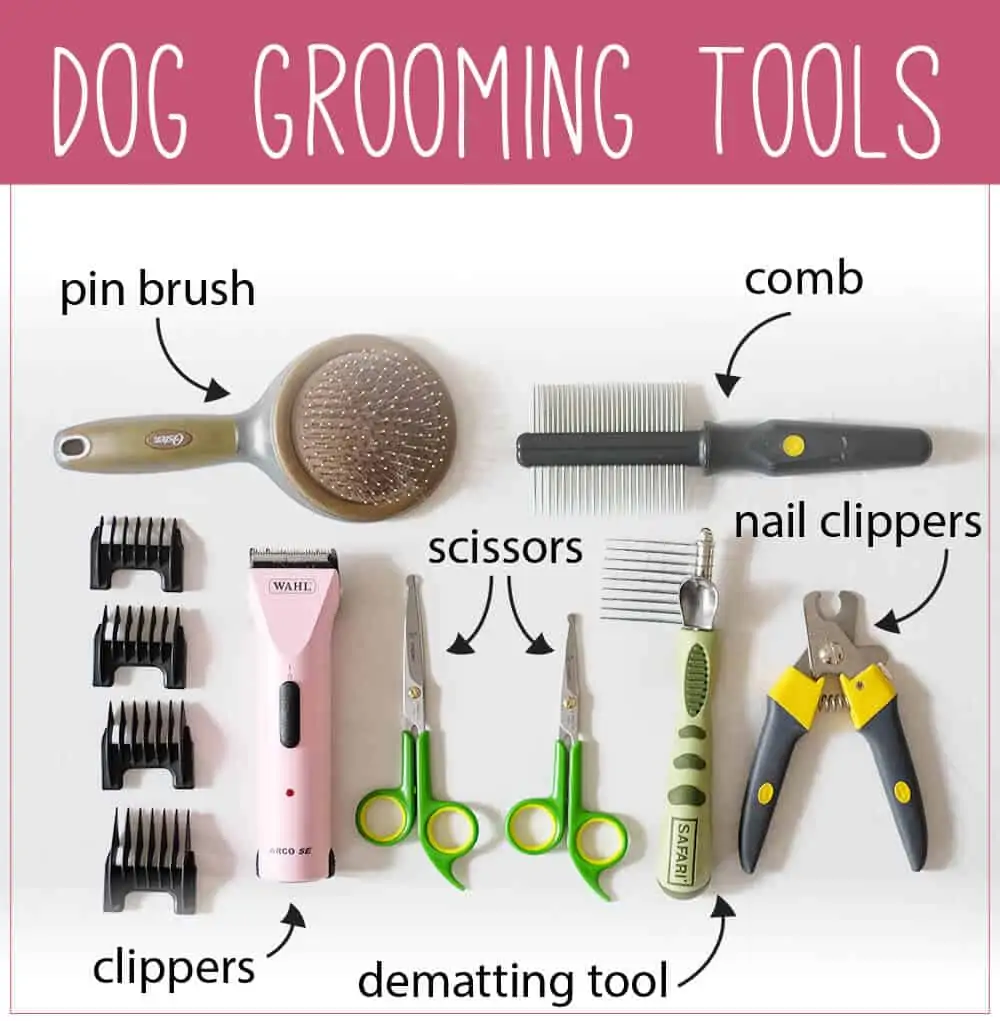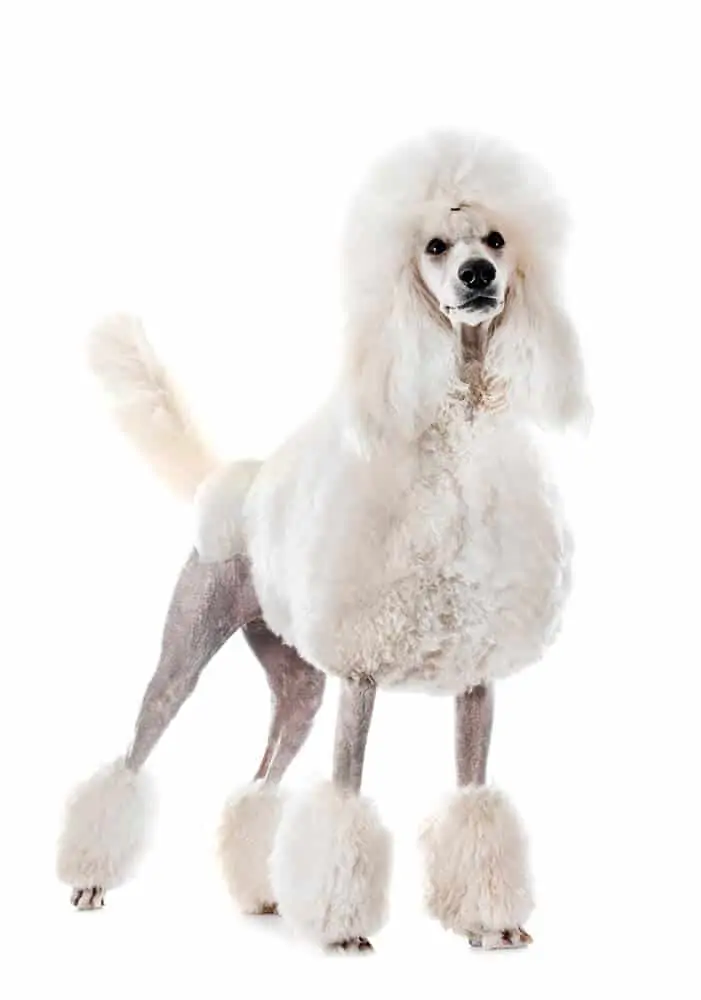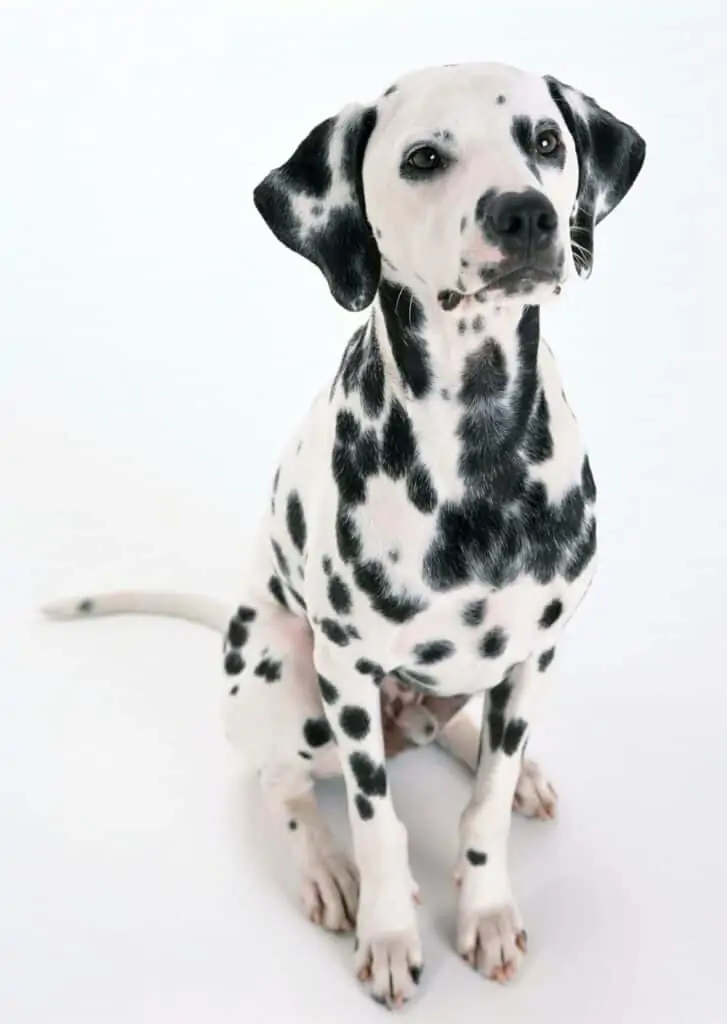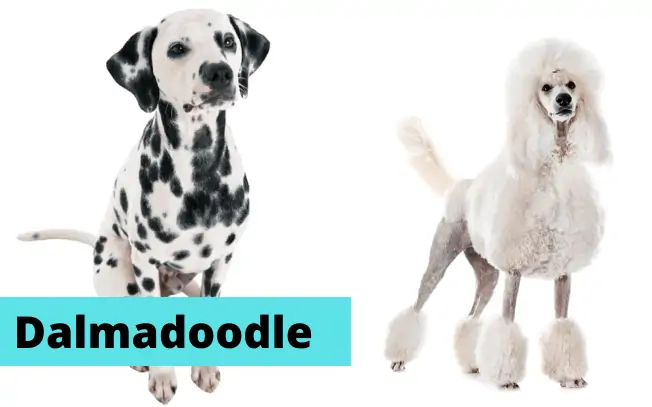Last Updated on
| Dalmadoodle Breed Facts | |
| Height | 20 to 23 inches |
| Weight | 41 and 70 pounds |
| Temperament | Intelligent, energetic, stubborn, sensitive, affectionate, alert |
What is a Dalmadoodle?
A Dalmadoodle is a Dalmatian Poodle mix dog.
These energetic, smart cookies also go by the names Dalmapoo, Dalmatiandoodle, and Dalmatianpoo.
Being a mixed breed, the Dalmadoodle isn’t recognized by the American Kennel Club, but that doesn’t make them any less cute!
Now, let’s learn about the Dalmadoodle’s appearance.
Appearance
Size
The Dalmadoodle is a large-sized dog—unless bred with a Miniature or Toy Poodle. They average around 20 to 23 inches tall and weigh between 41 and 70 pounds.
Female Dalmadoodles tend to be slightly smaller than male Dalmadoodles:
Average male Dalmadoodle size
- Height: 21-23 inches
- Weight: 45-70 pounds
Average female Dalmadoodle size
- Height: 20-22 inches
- Weight: 41-60 pounds
Colors
Oftentimes, Dalmadoodles spot the same spotted coat as their Dalmatian parent, but that’s not always the case. In fact, breeding a Dalmatian with a Poodle can result in a dog who may or may not have spots.
Although Dalmatian spots are dominant, the Dalmadoodle’s spot situation depends on the genetics of their parents and their individual expression of the Dalmatian spot gene.
Some Dalmadoodles may have spotted coats while others have solid coats like their Poodle parent.
Coats
Like other Poodle mix dogs, Dalmadoodles can have coats that range from straight, to wavy, to curly.
In most cases, Dalmadoodles will have a “hypoallergenic” and non-shedding coat with a slight bit of wave. Hypoallergenic is in quotes because there is no such thing as a true hypoallergenic dog.
People with allergies are allergic to the protein found in a dog’s dead skin cells, saliva, and urine. So, a low-shedding dog can help, but not always.
Grooming

When people think of Poodle mix dogs, they often say, ‘They must be easy to take care of, they don’t shed that often‘.
And that’s can’t be further from the truth.
Grooming a Doodle is a lot of work and the Dalmadoodle is no exception. Dalmadoodles have incredibly high-maintenance coats that require daily combing and brushing.
They will also most need monthly grooming (I recommend every six to eight weeks) where they can get their ears cleaned, their nails trimmed, and get a nice bath (along with a haircut).
Temperament and personality
To have a better and complete understanding of a Dalmadoodle’s personality, we first need to understand the parent breeds. Let’s learn a bit about the Poodle and the Dalmatian so we can see what a Dalmatian Poodle mix is like.
Poodle

Poodles are one of the oldest dog breeds, dating back to ancient times; perhaps this is why they are so intelligent, they’ve been exploring and learning for quite some time!
These dogs are well known for their highly intelligent trainability and also their playful friendliness.
Of course, Poodles are very well-known for their intelligence and are always up to learn new tricks, skills, and tasks. They can’t wait to see how happy you are that they successfully accomplished your command and receive lots of positive reinforcement and treats.
Proper training is crucial for Poodles, as their intelligent nature may cause them to pick up unwanted habits if not trained properly.
These dogs are known for their loving, friendly, and playful demeanor with both family members and strangers, as long as they are properly introduced.
Poodles can also get along well with other dogs, provided they are not used to being the sole dog in the household and receive proper socialization as a puppy.
Although Poodles may be excitable and vocal when encountering other dogs, they are also protective of their humans and have an abundance of love to give.
Overall, Poodles are affectionate and intelligent dogs who are eager to learn, play, and please their families!
Dalmatian

Dalmatians have been recognized as a breed since the 1800s, and they were historically engaged in various tasks that required both physical activity and intelligence.
Their duties included accompanying horse-drawn carriages, as well as performing in circuses. It’s impressive to see the wide range of activities these dogs were capable of.
These intelligent dogs thrive on human companionship and enjoy working alongside their owners. They possess remarkable energy and endurance, which makes them ideal for running and long walks. Additionally, Dalmatians are loyal and protective, making them great watchdogs.
Unfortunately, the breed has been associated with aggression since the release of Disney’s “101 Dalmatians,” which led to a surge in demand for Dalmatians, and thus, a surge in backyard breeders and unethical breeding practices as people tried to cash in on the extra demand.
However, when bred and raised appropriately, Dalmatians are friendly and loving dogs that can integrate well into families, although they are best suited for households with older children or no children as Dalmatians can become anxious and display aggression when deprived of proper exercise or subjected to inappropriate interaction with children.
Provided with enough mental and physical stimulation and raised in the right environment, Dalmatians make playful, intelligent, and loyal companions.
Dalmadoodle
Let’s see how the combination of a poodle and dalmatian parent play out for the Dalmadoodle pup, the verdict is pretty outstanding!
Intelligent
Dalmadoodles are quite intelligent just like their parents. They have an affinity for training and love being showered with praise and treats after successfully accomplishing their task or trick.
Stubborn
Dalmatians are known to have a stubborn streak, and this trait can be passed on to Dalmadoodles.
As a result, Dalmadoodles may require owners with plenty of patience when training and handling them. However, Dalmadoodles can be wonderful and loyal pets with the right training and socialization.
Sensitive
Something to be cautious of is the way you train your little pal though, they can be highly sensitive to tones and mean words, creating anxiety and timid behavior. Provide your loving companion with patients, guidance, and positive loving reinforcement and you two will be in perfect shape.
Affectionate
Dalmadoodles are known for their remarkable affectionate nature and devotion toward their family.
Like both their parents, they’re highly affectionate and loveable dogs who are eager to please.
Energetic
Both the Poodle and Dalmatian are energetic dogs with a desire to play, run, and engage in mentally enriching activities.
Alert
The Dalmadoodle is not an aggressive dog, therefore, a Dalmadoodle typically doesn’t make a good guard dog. They are, however, excellent watchdogs.
Thanks to their Poodle parent, Dalmadoodles are highly alert and will let you know when strangers are near.
Exercise needs
The Dalmadoodle requires a significant amount of daily exercise to maintain their physical and mental health.
They love to run and play in a fenced-in backyard, but they also enjoy going for walks, jogs, or hikes with their human companions. If you want a Dalmadoodle, you should aim to give them at least 90 minutes of exercise per day.
In addition to physical exercise, Dalmadoodles also need mental stimulation.
This can be achieved through interactive toys, challenging tasks, and games that engage their minds.
Socialization with other friendly dogs and humans is also important for their overall well-being. A trip to a private dog park can be a great way to meet up with dogs you know so your Dalmadoodle can play in a safe environment!
In summary, providing regular exercise and mental stimulation for Dalmadoodles is essential for their health and happiness. A minimum of 90 minutes of exercise per day and interactive toys and games can help keep them happy and well-behaved.
Health problems
With any dog, there are potential health concerns to be aware of. Here is a brief rundown of some of the issues a Dalmadoodle might face:
- Hip Dysplasia: Hip dysplasia is common amongst larger dog breeds. This is when the hip socket and bone do not develop properly, and grinding over time causes damage and potentially a loss of ability with that joint.
- Addison’s Disease: This disease indicates that a dog’s adrenal gland is not producing hormones that are extremely important for them. Their job is to regulate the dog’s organs. Without these hormones, dogs can experience lethargy, vomiting, diarrhea, weakness, and collapse, which can be life-threatening if left untreated. Thankfully, Addison’s Disease can be treated with the help of a vet.
- Cushing’s Disease: Cushing’s Disease is caused when a dog produces too much cortisol which is used to handle stress. A tumor is usually found after this diagnosis, it can be treated with surgery or medicine, but treatment can be costly.
- Skin allergies: Skin allergies can be caused by things outdoors (like grass or plants) or by certain types of food (like chicken). You can talk to your vet to help you identify what your Dalmadoodle is allergic to.
With all dogs, there are a few things you can do to limit the above health issues. First, buy a Dalmadoodle puppy from a reputable breeder that health tests the parents.
Next, make sure you feed your pup high-quality dog food and give them enough exercise throughout the day.
Lastly, take your dog to the vet frequently and keep vaccinations up to date!
Lifespan
The average lifespan for most Dalmadoodles is between 11-14 years.
Where to find Dalmadoodle puppies
Reputable breeders
The first place to find a Dalmatian Poodle mix is from a reputable breeder.
Reputable breeders will health test the parents to ensure no genetic diseases get passed onto the Dalmadoodle pups. They’ll also let you meet the parent dogs and see the breeding facility so you can get a feel for the temperament of the parents and make sure the pups will be raised in a healthy environment.
On top of health testing, a good breeder will want to interview you and screen you to ensure you’ll be a suitable owner for their pups.
It’s important to make sure you never purchase puppies from backyard breeders.
Dog rescues
Most people don’t realize that there are plenty of designer dog breeds in rescues waiting to find their forever homes.
Although you might not find a Dalmadoodle puppy up for adoption, you can certainly find other adult Dalmatian mix dogs and Poodle mix dogs who need homes.
The easiest way to see what dogs are available for adoption is to search through our list of Doodle-dog rescues to find Poodle mix dogs up for adoption near you!
Cost
Dalmadoodle puppies can be anywhere from $800 to over $1,000 depending on where you live. Pups with the iconic dalmatian spots are a little more on the expensive side.
Why you shouldn’t get a Dalmadoodle
Although the Dalmadoodle sounds like the perfect dog, there are definitely reasons why a Dalmadoodle might not be the right dog for you.
Since Dalmatians and Poodles are both high-energy dogs, you’ll be in for a surprise if you get the Dalmadoodle and are hoping for a chill dog.
This dog will want to romp, play, and run at all times!
And coming from two intelligent parent breeds, the Dalmadoodle needs proper training and mental stimulation to be happy. Without it, they can become aggressive and destructive. You’ll need to make sure to tire your Dalmadoodle out both physically AND mentally.
Second, being that the Dalmadoodle is a cross between a Poodle and a Dalmation, there’s a lot of grooming involved. Dalmadoodle dogs require daily brushing and frequent trips to the groomers.
If the grooming isn’t something you’re up for, you’ll want to reconsider this breed.
Lastly, if you lack patience, a Dalmadoodle isn’t a great choice. Being as they can be quite stubborn at times, patience and consistency are key qualities for Dalmadoodle owners.
Dalmadoodles are so cute, smart, and wonderful!
While we’re wrapping up here, let’s hit some main points surrounding the Dalmadoodle to determine if this is the right breed for you:
- These sporty pups need at least 90 minutes of physical activity per day
- Their coats require almost daily brushing and monthly trips to the groomers
- Expect to have them right by your side, ready for love, attention, playtime, adventuring, and learning
- Patients is key with training, as they can often be stubborn
With the right loving and active family, a Dalmadoodle will thrive and be one happy pup!
FAQs
Dalmadoodles are not recognized by the AKC. Currently, the AKC only recognizes purebred dogs and not does recognize designer dogs like the Dalmadoodle. They are, however, recognized by the American Canine Hybrid Club.
Like their parent breeds (the Poodle and the Dalmatian), Dalmadoodles are smart, loyal, and protective. They need lots of exercise and are active dogs.
Yes, they do. You will need to brush your Dalmadoodle daily and take them to the groomers every 6-8 weeks to keep their coats healthy and tangle-free.
This article may include affiliate links. www.travellingwithadog.com is a participant of Amazon.com Services LLC Associates Program. As an Amazon Associate, I earn a commission from qualifying purchase. www.travellingwithadog.com participates in other affiliate programs, and recieves commissions when purchases are made through the links. The cost is not inflated to account for the commission earned.
Veterinary Disclaimer: travellingwithadog.com is not a substitute for veterinary advice and does not intend to provide any type of veterinary advice for your animals. Please consult your vet for any questions you have regarding your pets health.

About the Author:
Dana owns a Sheepadoodle and a rescue merle Labradoodle. Her first dog growing up was a white Toy Poodle and she’s loved dogs ever since. She has years of experience fostering dogs and has helped find homes for a variety of different breeds, both large and small! After seeing so many dogs end up unwanted and in shelters, she began blogging about different dog breeds (specifically Doodle dogs, since that’s what she knows best) to help people make informed choices when adding a new member to their family.
When Dana’s not brushing her Doodles’ hair (it takes a lot of time for two!) you can find her playing nose work games and fetch with her two amazing pups.
Learn more about her here.

